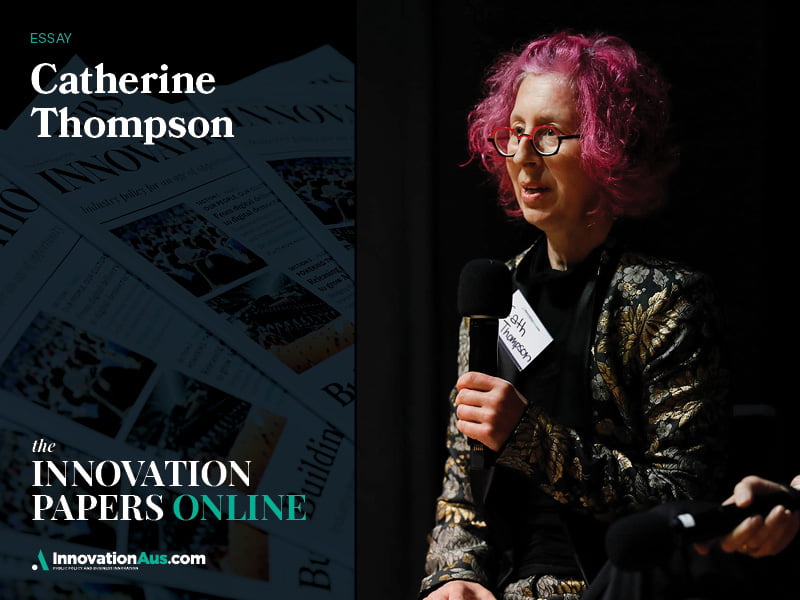The Innovation Papers’ invitation to provide a visionary reimagining of government Information and Communications Technology (ICT) procurement should have filled my life with sunshine. So why the disconsolate mien of someone who has been handed a box of chocolates to find that only the strawberry crèmes remain on the top layer?
It is because I am staring at the strawberry crèmes of procurement, which have not been made any more palatable by years of being handed around. They are Transparency, Value, and Capability, and unless someone eats them up, we can’t in good conscience move on to the delights of Strategy and Purpose that might be found in the layer beneath.
This trio are foundational to our collective ability to engage in democratic practices of informed enquiry, to support public oversight and advocacy, and to turn government’s substantial ICT spending power to the advantage of its own economic base.
ICT procurement is not an intractable problem for government, even though inaction – and sometimes backsliding – on the findings of the 2017 ICT Procurement Taskforce (and its many and consistently worded predecessors) might lead to that conclusion.

What has to date been lacking is a focus on the basics; a plan to get them right; and the appetite and energy to commit to such a plan.
This piece explains why these first steps are important and what simple changes we could usefully make now. Rather more controversially, it suggests who should take them.
And when this work is done – and only then – will we be able to access the power of our procurement for innovation to the public good.
Transparency: first fix the data!
The benchmark for basic procurement competence is that we understand what is bought from whom, and optimally at what price. At the federal government level, we cannot currently tell this with any degree of confidence, and nor has it been considered a government priority to do so.
Data is a national asset. And accurate and publicly accessible public sector procurement data is valuable to industry and civil society, as well as to government itself.
For those looking to sell to government, the data is market intelligence. For civil society, data transparency encourages engaged citizenship and promotes public sector accountability.
For government, it helps gauge the success of ICT policies such as cloud-first, and also provides data-driven inputs to new government technology and industry policy. Uncomfortably, this probably means that any current policies based on understanding how spend flows to sellers are at the very least questionable.
The Australian National Audit Office’s (ANAO) 2020 review of ICT panels hazarded that in the 2018-19 financial year, contractual technology commitments might be $3.9 billion.
The 2017 ICT Procurement Taskforce’s estimates from 2010 to 2016, however, dropped no lower than $5.9 billion (and peaked at $9 billion).
It is notable that the Taskforce abandoned its attempts to wrangle the raw data from the AusTender repository and instead turned to Intermedium’s curated dataset. The government’s response to the Taskforce report formally acknowledged the limitations of the data. Yet, nothing has changed in the five years since the report’s release.
The challenge lies not in the paucity of data, but in its lack of explanatory power. The root cause of this failing is that the dataset is not actively curated.
Although the database is centrally held, each agency contributes to it according to its own lights, navigating the complex coding structure as best it may and providing text descriptions as it sees fit. Some relevant fields are missing.
Although agencies may respond to outside enquires with more information, they are not required to do so and the Freedom of Information (FoI) process represents the only formal pathway to greater detail.
In April, InnovationAus.com wrote a piece on the Australian Electoral Commissions’ (AEC) new electoral management software. The AusTender entry reads “software”. “Work Order E01” for a cost of $20.4 million. That’s not transparency.
I offer a quick and simple prescription to bring federal ICT procurement spend intelligence up to the level enjoyed by private sector counterparts.
First, designate a data custodian with formal accountability for the quality of the data. Then, create a simple taxonomy of ICT expense categories to replace the current coding.
Adopt this taxonomy into the chart of accounts of central agencies, which will not only reduce complexity but also create consistency between agency general ledgers and the public record of their procurement.
Next, indicate whether contracts are fixed price or capped, originals or amendments, and split multi-year contracts into annual spends.
All three actions will contribute to more accurate forward estimates. Lastly, make this data (publicly) discoverable by means of user-friendly data visualisation tools.
As a side note, the need for a source-of-truth dataset is more acute where alternative sources of data have been progressively and quietly shelved.
The ICT Trends report that provided annual information drawn from agency general ledgers ceased publication some years ago, and in May this year the detailed Digital Marketplace reporting on spend, opportunity type, winners and average pricing discretely vanished when Marketplace was re-platformed onto commercial software.
I reflect on how humdrum and transactional these recommendations appear. But then: how much clearer do recommendations need to be before change is enacted?
The stories we tell in today’s digital world are all narrated with data. As accountable public servants and citizens, if we fail to roll up our sleeves and engage with this and other imperfect narrations, we are failing both the nation and ourselves.
Value: lifting the veil on opportunity and performance
ICT procurement activity in government mostly happens behind closed doors. The record of open tender opportunities is highly obfuscated by the incidence of purchases from panels, which are counted as open tenders, regardless of whether any competition is involved.
In the absence of any notable changes to ICT procurement customs, we can assume that open competition remains limited to ~25 per cent of opportunities, as noted by the ICT Taskforce.
The tendency to drag the veil of secrecy over ICT procurement is nowhere more marked than on the Digital Marketplace, a platform whose original purpose was to make ICT opportunities more accessible to a wider range of non-traditional suppliers to government.
Now, however, 75 per cent of its opportunities are restricted to buyer-nominated bid lists. Not only are other pre-qualified sellers locked out of submitting for these opportunities, but the opportunity details are visible to no-one but invited bidders. (I have written more extensively on the topic of panels and marketplaces in Stirring the Pot on Marketplaces).
Making the details of government procurement opportunities and tender documents inaccessible by default is a questionable practice. From such documents, we can learn about government needs, how government funding is being deployed, and the skill and expertise with which market approaches are being crafted.
The only winner now is the multi-million-dollar probity industry, which acts as a proxy for process scrutiny until the point of contract award.
The performance of significant procurement initiatives post-award is equally opaque. Progress and performance reporting helps to illuminate the quality of initial and lifecycle value-for-money assessments.
Such reporting speaks to the effectiveness of the government technology commissioning environment and implicitly also supplies a judgement on the expertise of the sourcing and project management teams.
It is for this reason that the ICT Procurement Taskforce recommended the creation of a public dashboard to report the spend, progress and benefits of significant ICT projects, along the lines of those offered by several state governments.
The government of the day pushed back on the recommendation, opting instead to report the information only to in-house audiences. What early opportunities to publicly query cost overruns and failing projects have been missed as a result? Would the Digital Passenger Card, for example, have cost $60 million before it was shelved?
It is not technically challenging to make procurement opportunities, processes and outcomes more public where this does not conflict with the national interest.
Psychologically, however, it is terrifying: I understand that. But public institutions should not duck public accountability.
Capability: how can we make change happen?
Assuming that we are willing to fix ICT procurement data, opportunities and reporting, who should be tasked with the work? Logic dictates that the parties that have had the opportunity to enact change and have not done so should take a back seat now.
The Department of Finance has owned the ICT procurement dataset for many years but has failed to materially improve its quality.
Likewise, the instinct of the Digital Transformation Agency has been to withdraw insights from the public gaze – not limited to procurement, but also including the performance of government digital services.

It has almost ceased to perform (still mandatory) Digital Service Standard assessments and has killed off its very basic digital service reporting dashboard. Implicitly, both agencies have disqualified themselves from the task.
And what of the profession and practice of technology procurement itself? Let’s be clear: public sector ICT procurement does not perform to the standard of its private sector counterparts.
The ANAO’s 2020 report on ICT panels kicks off by explaining that “procurement is the process of acquiring goods and services”, and sadly, this very tactical definition accurately reflects the role and expectation of ICT procurement in government today.
Federal ICT procurement essentially functions as a conveyor belt for goods and services into government in ways that comply with the Commonwealth Procurement Rules. Industry models are both more sophisticated and more accountable.
Most adopted a category management mindset over a decade ago. Category management is a strategic approach in which procurement professionals are responsible for the development of a supply segment, including its spend profile, supply base, and market facing activities.
They are also accountable for the attainment of agreed cost and quality targets. Leading industry functions have extended their reach beyond go-to-market activities, and they actively manage post-sourcing supplier relationships and supplier performance.
They recognise, for example, that sophisticated suppliers have multiple touchpoints within their organisation and coordinate their own responses at a strategic level. They know that unmanaged contracts typically bleed 40 per cent to 60 per cent of their benefits over a three-year lifespan and they track both benefit delivery and relationship status.
The ICT Procurement Taskforce, as well as more general and more recent reviews of APS capability, called out the difficulty of attracting top procurement talent or training it up in-house. Procurement is not a federal career path.
The current challenge for public sector buyers, supported neither by the digital-age procurement platforms that could inform their go-to-market activities, nor by professional formation or qualifications, is that they may not have the expertise to articulate an optimal procurement outcome, or even to recognise one.
This combination of capability and will is the void at the heart of our current ICT procurement. If we are bridge it – to take ICT procurement as seriously as industry counterparts do – we need at a minimum to take the actions I have outlined.
These actions are acknowledged as “far-reaching improvements” by former Assistant Minister Angus Taylor in his response to the report of the ICT Taskforce.
I am therefore proposing that we create an independent, ICT commercial services agency. It could easily be funded by the transaction clip on whole-of-government ICT contracts that netted the DTA a cool $36 million in Financial Year 2020-21.
This agency would operate on leading-practice commercial principles and do so transparently to the public. Although a central agency mandate would (sadly) be necessary to its success, it would combine a centre-led approach with the service mentality familiar to procurement professionals.
It would also help to other agencies and tiers of government, and to the not-for-profit sector. It would be responsible for curating ICT spend data and assuring its accuracy. It would be responsible for open data and open contracting initiatives as evidenced in other jurisdictions.
Its category managers would provide market intelligence and sourcing expertise to support agency buyers whose work does not bring them into regular contact with ICT supply markets. These category managers would look beyond sourcing activities to understand and manage the nature and extent of supply relationships and supplier performance and to shape the post-sourcing environment.
They would develop and lead overall supply strategies to deliver on the government’s digital and technology directions. They would be responsible for social and environmental procurement targets, as well as for the overall cost and quality performance of their category.
This is not an outrageous vision. It merely describes the everyday function of a professional procurement operation in the private sector.
Such an operation would also be running catalogue-based transactional procure-to-pay and e-tendering platforms of the kind that would be useful to government; evaluating supply chain risk levels; and developing the professionalism of its people.
Indicatively, at least in the early years of their establishment, highly effective procurement teams could reasonably be expected to deliver ten times their cost (‘10x’) as financial benefits to the bottom line of their customer base.
Beyond Procurement 101
But there is an outrageous proposition, and it is one that public sector procurement is uniquely positioned to deliver. This is not a new idea, as it underpinned the National Innovation & Science Agenda (remember that?) funding for the Digital Marketplace.
The proposition is to consciously deploy government ICT spending as an instrument of economic and social policy.
Procurement is a natural organisational gateway, facing as it does both inwards to its clients and outwards to its supplier base. As the voice of the organisation, it articulates customer needs to suppliers, while its supply market development activities should ensure that a range of sellers are nurtured to compete successfully.
Several government initiatives also seek to achieve a competitive local supply market and do so through the ‘hand out’ route of funding. Procurement’s opportunity is to provide a hand up, by awarding business, building supplier reputations through referenceable contracts, and helping smaller entities understand how to service large organisations.
At our point on the maturity curve, this is an aspiration rather than a practical proposition. I have touched here on only a few foundational practices and precepts for sound public sector procurement.
Other challenges remain, including, for example, the intense geographic supplier concentration on Canberra; the SME procurement percentages that embrace 200 employee firms, the dearth of industry and government technology policies to which procurement efforts can align, and the need to rethink ICT budgeting and funding for the digital age.
The DTA advice on procurement innovation leads off by recommending that buyers “consult multiple sellers to determine suitable products or services” as an alternative to “a traditional sourcing approach.”
Let’s start with correcting the basics such that consulting multiple suppliers doesn’t head the innovation checklist.
Perhaps then the ANAO can rewrite its definition to say: “government procurement is the active lifecycle management of supply markets in order to achieve transparently reported technology, financial and social outcomes that promote better government and the wellbeing of the people”.
And then, when our rhetoric is not louder than our actions, we can chart the contribution that really visionary procurement could make.
Catherine Thompson is a former Chief Procurement Officer at a Big Four bank, with 30 years of international procurement experience in senior leadership roles in consulting and industry. She has written widely on procurement innovation and provided expertise to the 2017 ICT Procurement Taskforce. Also a technologist, Catherine was one of the Digital Transformation Office’s foundational leaders, and led the team that designed and built the Digital Marketplace.
Do you know more? Contact James Riley via Email.


The Australian Public need this sort of data and transparency across all of government procurement. A really good example of a state in the US doing it the right way is the Florida FACTS system which provides the category of purchase, full value, dates, deliverables even broken down to the milestones, payments made and the actual contract that was entered into. For contacts extending multiple years, the yearly performance review is also uploaded. The agencies justification and delegate approval documents are also uploaded for contracts.
Now that’s transparency and accountability!
https://facts.fldfs.com/Search/ContractSearch.aspx
In the 70s there was data – think, Data Processing (DP). In the 80s and 90s data evolved into information – think Information Management (IM). In the noughties information evolved into intelligence – think, Business Intelligence (BI). In 2022 intelligence devolved right back to data – think flared trousers, the Bee Gees and Malcolm Fraser. Back to the future guys. Next stop is magnetic tape and punch cards? The 60s …